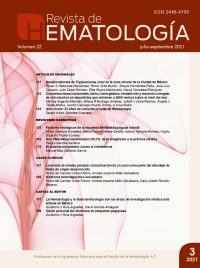FMS-like tyrosine kinase 3 (FLT3) gene: From the biogenesis to the medical practice.
Rev Hematol Mex. 2021; 22 (3): 162-174. https://doi.org/10.24245/rev_hematol.v22i3.6962
Heidys Garrote-Santana
Instituto de Hematología e Inmunología, La Habana, Cuba.
Resumen
El gen FMS-like tyrosine kinase 3 (FLT3) codifica para un receptor indispensable en el desarrollo, proliferación y supervivencia de las células hematopoyéticas. Este artículo describe las características biológicas del gen, el funcionamiento normal y patológico de la proteína y las principales mutaciones de interés en la práctica médica. El FLT3 se localiza en el cromosoma 13 y está constituido por 24 exones. La síntesis de la proteína y la activación posterior dependen de diferentes procesos celulares y del FLT3 ligando. Entre las alteraciones más importantes del gen destacan por su frecuencia e implicación en el pronóstico de las enfermedades, la duplicación interna en tándem en la región codificante del dominio yuxtamembrana (FLT3-ITD) y las mutaciones puntuales en el dominio tirosina cinasa (FLT3-TKD). Estas mutaciones son de especial interés para la toma de decisiones terapéuticas en la leucemia mieloide aguda. La alteración FLT3-ITD está descrita hasta en un 25% de los pacientes con leucemia mieloide aguda y constituye un predictor independiente de mal pronóstico y mayor riesgo de recaída. El cociente alélico (AR) FLT3-ITD, que refleja la carga leucémica, tiene un papel significativo, donde el AR < 0.5 o ≥ 0.5 define categorías de pronóstico. En lo referente a los esquemas terapéuticos, los ensayos clínicos con inhibidores de la proteína FLT3, dirigidos a las mutaciones FLT3-ITD y a las FLT3-TKD, han abierto una puerta a la medicina de precisión en la leucemia mieloide aguda; sin embargo, aún quedan obstáculos por superar, como la toxicidad, especificidad y la resistencia en el paciente.
PALABRAS CLAVE: gen FMS-like tyrosine kinase 3; leucemia mieloide aguda.
Abstract
The FMS-like tyrosine kinase 3 (FLT3) gene encodes an essential receptor in the development, proliferation and survival of hematopoietic cells. This article describes the biological characteristics of the gene, the normal and pathological functioning of the protein, and the main mutations of interest in medical practice. FLT3 is located on chromosome 13 and is made up of 24 exons. Protein synthesis and subsequent activation depend on different cellular processes and the FLT3 ligand. Among the most important alterations of the gene, the internal tandem duplication in the coding region of the juxtamembrane domain (FLT3-ITD) and point mutations in the tyrosine kinase domain (FLT3-TKD). These mutations are of special interest for making therapeutic decisions in acute myeloid leukemia (AML). The FLT3-ITD alteration is described in up to 25% of patients with acute myeloid leukemia and is an independent predictor of poor prognosis and increased risk of relapse. The allelic ratio (AR) FLT3-ITD, which reflects the leukemic burden, has a significant role, where the AR < 0.5 or ≥ 0.5 defines prognostic categories. Regarding therapeutic regimens, clinical trials with inhibitors of the FLT3 protein, targeting both FLT3-ITD and FLT3-TKD mutations, have opened a door to precision medicine in acute myeloid leukemia, however, there are still obstacles to overcome such as toxicity, specificity and resistance in the patient.
KEYWORDS: FMS-like tyrosine kinase 3; Acute myeloid leukemia.
Recibido: 11 de octubre 2021
Aceptado: 25 de octubre 2021
Este artículo debe citarse como: Garrote-Santana H. Gen FMS-liketyrosinekinase3 (FLT3): de la biogénesis a la práctica médica. Hematol Méx 2021; 22 (3): 162-174.

